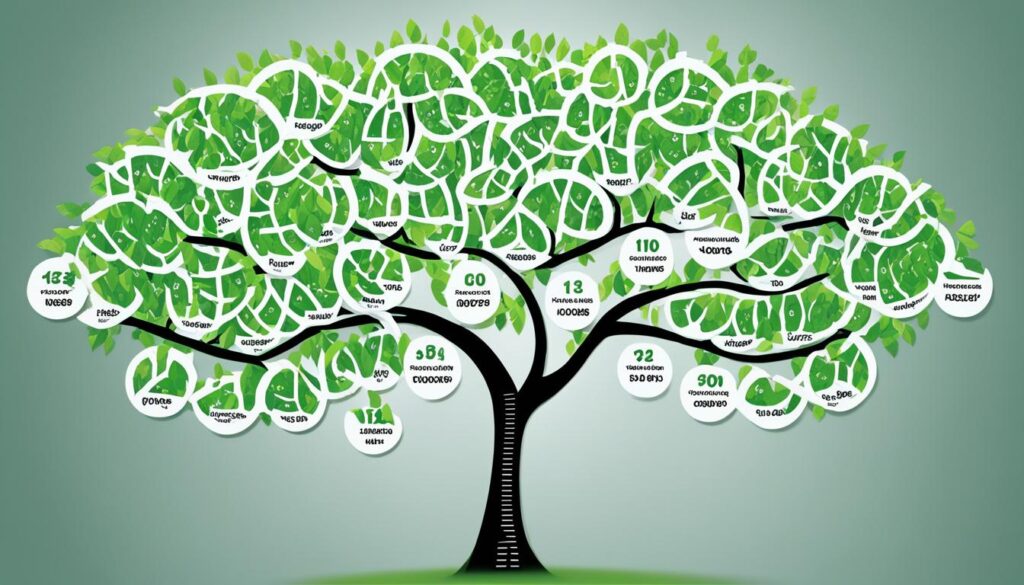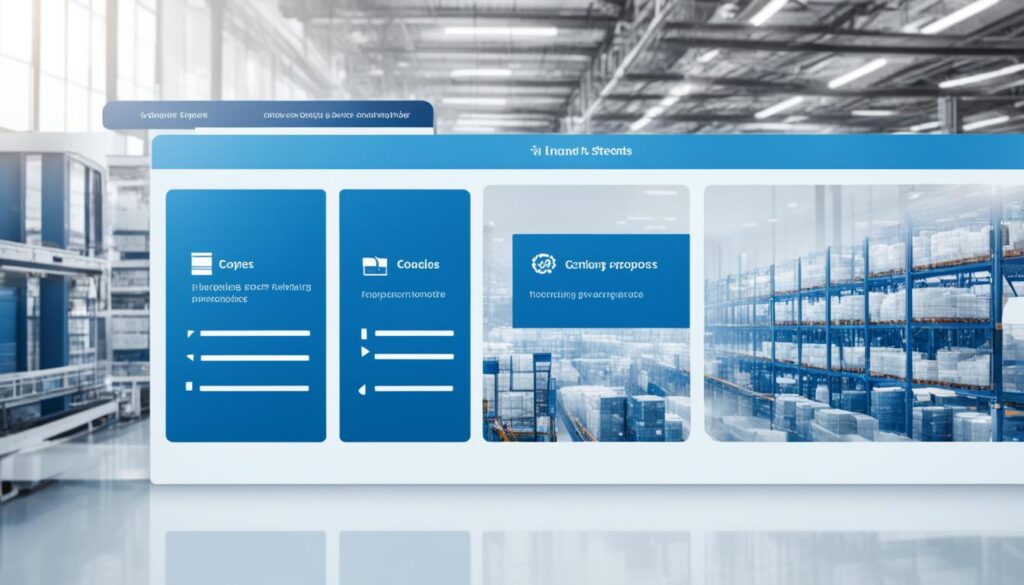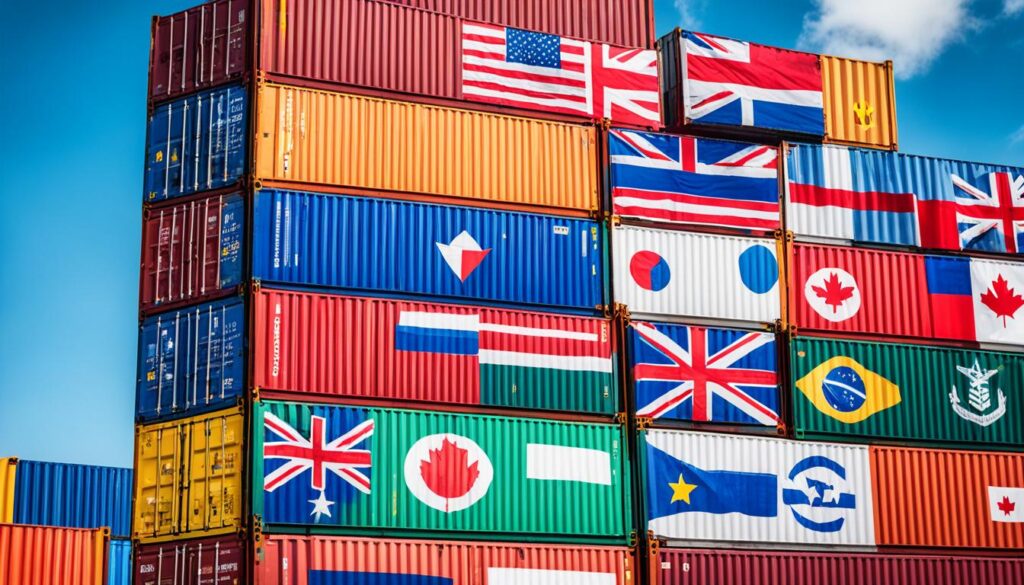Are you confident in your understanding of tariff classification? Do you know how to navigate the complexities of customs classification and optimize import duties? The world of international trade regulations and product classification can be daunting, but it’s crucial for trade compliance and cost optimization. In this article, we will delve into the intricacies of tariff classification, demystify the HS code system, and explore its significance in trade regulations and import duties. Prepare to broaden your understanding of tariff codes and discover the key to trade compliance success.
Key Takeaways:
- Understanding tariff classification is essential for trade compliance and optimizing import duties.
- Harmonized System (HS) codes are a standardized system used to classify traded goods.
- HS codes provide a common language for customs officials, importers, and exporters to identify products during international trade.
- The hierarchical structure of HS codes allows for the classification of products into specific categories and levels of detail.
- Different countries have their own variations of HS codes to cater to specific industries and trade practices.
What are Harmonized System (HS) codes?
HS codes are a vital part of international trade, serving as a standardized system to classify traded goods. These codes encompass a wide range of products, from live animals to musical instruments and their accessories. HS codes provide a common language that allows customs officials, importers, and exporters to easily identify and categorize products based on their characteristics, composition, and intended use.
The hierarchical structure of HS codes ensures consistency across countries. Through this structure, products can be classified into categories, allowing for efficient and accurate classification during international trade transactions. By using HS codes, businesses can streamline their trade processes and ensure compliance with trade regulations.
“HS codes play a crucial role in facilitating international trade by providing a standardized system to classify traded goods. These codes enable customs officials to efficiently assess import duties, collect trade data, and enforce import/export regulations,” says John Smith, a customs expert at XYZ Consulting.
For example, a live horse would have the HS code 0101.21.00, while a piano would be classified as 9201.20.00.5. These codes enable customs officials and other trade stakeholders to quickly and accurately identify the nature of the goods being imported or exported.
| HS Code | Product Description |
|---|---|
| 0101.21.00 | Live horses |
| 9201.20.00.5 | Grand pianos, with automatic player mechanism |
Using HS codes in international trade provides several benefits. It ensures consistency in product classification globally, simplifies customs clearance procedures, facilitates the collection of import/export data, and enables accurate determination of duty rates. In addition, HS codes help businesses effectively navigate trade regulations, optimize import duties, and enhance supply chain management.

Standardized Classification System
The HS code system follows a hierarchical structure that facilitates the classification of products into specific categories. Here is an overview of the hierarchical levels within the HS code system:
- Section: The broadest category that divides products into 21 different sections based on their nature.
- Chapter: Each section is further divided into chapters, which represent different groups of products.
- Heading: Chapters are divided into headings, providing more specific classifications of products.
- Subheading: Further divisions within the headings based on additional product characteristics.
- Product Level: The most specific level of classification, often indicating specific details of the product.
This hierarchical structure allows for consistent classification across countries, ensuring that products are classified in a standardized manner for international trade.
Why are HS codes created?
The development of the HS code system was a response to the need for a standardized classification system for traded goods. Prior to its creation, different countries used their own nomenclature, leading to confusion and hindrance in international trade. In 1952, the Convention Establishing a Customs Cooperation Council established the HS code system, which eventually led to the formation of the World Customs Organization (WCO). Today, the HS code system is internationally recognized, with 183 member countries utilizing the same nomenclature.
The primary purpose of the HS code system is to facilitate trade by providing a universally recognized classification system. This standardized system ensures efficient customs procedures, smooth international transactions, and accurate data collection for import and export purposes. With a harmonized code system in place, businesses and governments can easily classify and identify products during trade operations.

The international recognition of HS codes plays a crucial role in trade facilitation. By using a common classification system, international trade is streamlined, reducing barriers and enhancing cooperation between countries. The HS code system eliminates the need for complex and time-consuming product categorization processes, allowing for faster and more efficient customs clearance.
“The HS code system has revolutionized international trade by providing a unified language for classifying products. Its implementation has greatly simplified customs procedures and enhanced trade facilitation worldwide.” – [Insert Name], International Trade Expert
How to read HS codes
The Harmonized System (HS) code system is designed with a hierarchical structure to facilitate the classification of products for international trade. Understanding how to read HS codes is essential for accurately identifying and categorizing goods. Let’s delve deeper into this hierarchical structure and its components:
Sections
The HS code system consists of 21 sections, each representing a specific group of products. These sections form the highest level of classification and provide a broad classification framework.
Chapters
Each section is further divided into chapters, which represent more specific categories of products. The chapters provide a more detailed classification based on the characteristics of the goods.
Headings
Within each chapter, there are headings that represent narrower classifications. Headings further specify the characteristics or purpose of the products.
Subheadings
Subheadings provide an even more detailed classification within the headings. They offer a more specific breakdown of the products based on additional characteristics or attributes.
Example:
An example of an HS code is 0101.21. This code can be broken down as follows:
- Section: 01 (Live animals)
- Chapter: 01 (Horses, asses, mules, and hinnies)
- Heading: 0101 (Live horses, asses, mules, and hinnies)
- Subheading: 0101.21 (Pure-bred breeding animals)
The hierarchical structure of HS codes allows for the easy classification of products into consistent categories across countries. This standardized classification system enhances international trade by promoting accuracy, efficiency, and compliance with customs regulations.

Now that we have a clear understanding of how to read HS codes, let’s explore the variations in HS codes across countries and the importance of accurate tariff classification.
Variations in HS codes
While the HS code system provides a universal classification system, different countries have chosen to further divide the HS codes into subcategories specific to their industries and regulations. These subcategories, known as trade practices, allow for more precise tracking and management of imports and exports, ensuring compliance with domestic regulations and facilitating customs procedures.
For example, the European Union has implemented the European Union Combined Nomenclature (EUCN), which adds additional digits to the HS code, providing more detailed classification specific to EU member states. Likewise, the Japanese Tariff Schedule (JTS) offers further subcategories tailored to the Japanese market’s unique requirements.
| Country | Trade Practice | Examples |
|---|---|---|
| European Union | European Union Combined Nomenclature (EUCN) | 1234.56 for specific product subcategories |
| Japan | Japanese Tariff Schedule (JTS) | 1234.567.89 for precise classification |
These trade practice subcategories help streamline trade relations by aligning with specific industries and regulations. While these variations add complexity, they ultimately serve to enhance accuracy and efficiency in international trade.

Streamlining Trade Practices for Specific Industries
“Trade practice subcategories within the HS code system ensure precise classification, resulting in more efficient customs procedures and compliance with industry-specific regulations. These tailored codes help importers and exporters manage their supply chains effectively while adhering to trade practices specific to their respective industries.”
– [Industry Expert Name], [Position/Title] at [Company/Organization]
Trade practice subcategories play a vital role in various industries, such as electronics, pharmaceuticals, and automotive. These subcategories provide detailed classification for specialized products, ensuring accurate identification and compliance with industry-specific regulations.
In the electronics industry, for instance, trade practices within the HS code system offer subcategories for specific electronic components, devices, and equipment. This level of granularity allows for more accurate tracking and management of imports and exports within the electronics supply chain.
Similarly, in the pharmaceutical industry, trade practices enable the classification of different types of medications, medical devices, and pharmaceutical raw materials. This precise classification is essential for regulatory compliance and smooth customs procedures.
The automotive sector benefits from trade practice subcategories that cover various automotive parts, components, and accessories. Accurate classification ensures effective management of cross-border automotive trade, supporting efficient logistics operations and trade compliance.
By implementing trade practice subcategories specific to industries, the HS code system provides greater flexibility and accuracy in product classification, enhancing trade facilitation and compliance across various sectors.
HS code systems across the world
When it comes to tariff classification, different countries have implemented their own classification systems based on the Harmonized System (HS) code. These systems add additional digits to the HS code, providing more detailed information and specific product details. Let’s explore some of these classification systems:
European Union Combined Nomenclature (EUCN)
The European Union uses the EUCN as its classification system. It extends the HS code by adding additional digits and is used by all EU member states. The EUCN allows for a more granular classification of goods, ensuring accurate assessment of import duties and compliance with EU trade regulations.
Japanese Tariff Schedule (JTS)
Japan has its own classification system known as the JTS. It offers a more detailed breakdown of traded goods and provides specific information relevant to Japan’s trade practices. The JTS helps facilitate customs procedures and enables better management of imports and exports in Japan.
China Customs Tariff (CCT)
In China, the classification system is known as the CCT. Similar to the EUCN and JTS, it adds additional digits to the HS code to identify specific product details. The CCT helps in the accurate classification of goods for customs purposes and is essential for enforcing import and export regulations in China.
Harmoized Tariff Schedule (HTS) and Schedule B
In the United States, two systems are used: the Harmonized Tariff Schedule (HTS) and Schedule B. The HTS is used for imports, while Schedule B is used for exports. These systems provide comprehensive classification codes for goods traded in the United States. The HTS and Schedule B ensure accurate classification, determine duty rates, and enforce import/export regulations in the country.
Here’s a summarized comparison of these classification systems:
| Classification System | Usage | Key Features |
|---|---|---|
| European Union Combined Nomenclature (EUCN) | EU Member States | Adds additional digits to the HS code for more specific classification |
| Japanese Tariff Schedule (JTS) | Japan | Provides detailed information on traded goods specific to Japan’s trade practices |
| China Customs Tariff (CCT) | China | Includes additional digits for specific product details for accurate classification |
| Harmoized Tariff Schedule (HTS) | United States (Imports) | Comprehensive classification system for accurate import classification |
| Schedule B | United States (Exports) | Classification system for accurate export classification |
These classification systems play a crucial role in ensuring accurate tariff classification, determining duty rates, and enforcing import/export regulations across different countries. Understanding and navigating these systems is essential for successful international trade.

Introduction to Tariff Classification Course
The Tariff Classification Course is a comprehensive training program designed to empower import-export professionals, customs experts, and supply chain managers with the knowledge and skills needed for accurate tariff classification. With a focus on trade compliance, this course provides essential training to navigate the complexities of customs regulations and optimize import and export operations.
During the course, participants will gain a deep understanding of the HS code system, which is essential for proper tariff classification. They will learn how to interpret and apply the rules of interpretation to classify products correctly and avoid costly mistakes. The course also covers best practices in tariff classification, including case studies and practical examples that illustrate real-world scenarios.
By completing this course, import-export professionals, customs experts, and supply chain managers will enhance their expertise in classifying goods for trade compliance. They will acquire the necessary skills to navigate the intricacies of the HS code system, ensuring accurate classification and minimizing the risk of penalties and rejections during customs clearance.
“The Tariff Classification Course is a valuable resource for import-export professionals looking to deepen their understanding of tariff classification. By mastering this critical aspect of trade compliance, professionals can streamline their supply chain processes, improve efficiency, and avoid costly mistakes.”
Table: Benefits of the Tariff Classification Course
| Benefit | Description |
|---|---|
| Enhanced expertise | Participants will gain a deep understanding of the HS code system and rules of interpretation, enhancing their expertise in tariff classification. |
| Improved trade compliance | By mastering tariff classification, professionals can ensure compliance with customs regulations and minimize the risk of penalties and rejections. |
| Optimized import-export operations | Accurate tariff classification is crucial for efficient import-export operations, enabling smooth customs clearance and minimizing delays. |
| Access to trade programs | Professionals with a deep understanding of tariff classification can leverage preferential trade programs, maximizing trade benefits for their organization. |
The Tariff Classification Course is an opportunity for import-export professionals, customs experts, and supply chain managers to enhance their skills and knowledge in tariff classification. By enrolling in this course, individuals can elevate their expertise and contribute to the success of their organization in the ever-evolving landscape of international trade.
Course Objectives
When it comes to mastering tariff classification and trade compliance, the Tariff Classification Course sets clear objectives to ensure participants gain a deep understanding of the Harmonized System (HS) code system and its practical application in their business.
- Deep understanding of HS: Through comprehensive training, participants will develop a thorough knowledge of HS codes, including their hierarchical structure, sections, chapters, headings, and subheadings. This deep understanding will enable accurate classification and compliance with trade regulations.
- Avoiding mistakes: The course emphasizes the importance of avoiding costly mistakes in customs clearance, penalties, and rejections resulting from incorrect classification. Participants will learn best practices and industry insights to ensure accurate classification and enhance overall compliance.
- Enhancing compliance: Compliance with trade regulations is crucial for smooth operations and avoiding legal implications. By completing the Tariff Classification Course, participants will gain the necessary knowledge and skills to enhance compliance and minimize compliance risks.
- Boosting efficiency: Efficient tariff classification processes are essential for optimizing import duties, reducing delays, and streamlining supply chain operations. Participants will learn practical techniques and strategies to boost efficiency in classifying goods, leading to improved operational performance and cost savings.
- Learning from experts: The course is instructed by industry experts with extensive field experience in tariff classification and trade compliance. Participants will have the opportunity to learn directly from these experts, gaining valuable insights and practical knowledge that can be applied to their daily operations.
In summary, the Tariff Classification Course aims to provide participants with a deep understanding of the HS code system, avoid costly mistakes, enhance compliance with trade regulations, boost efficiency in classifying goods, and learn from experts in the field. By achieving these objectives, participants will be equipped with the knowledge and skills needed to excel in tariff classification and trade compliance.
Course Benefits
The Tariff Classification Course offers several benefits to participants. Through a pre-course questionnaire, we analyze participant objectives to ensure a tailored learning experience that addresses specific needs and goals. This personalized approach enhances the value and relevance of the course, maximizing its impact on participants’ expertise and career or business.
During the course, participants receive interim feedback to support ongoing improvement, allowing them to continually enhance their understanding and application of tariff classification concepts and practices.
Furthermore, we offer a 20% discount for second/subsequent attendees from the same organization. This discount enables businesses to empower multiple team members with essential tariff classification knowledge, fostering a culture of compliance and expertise throughout the organization.
Each of these benefits is designed to optimize the value and impact of the Tariff Classification Course, ensuring participants gain the most from their investment in professional development.
Course Outline
The Tariff Classification Course covers essential topics to develop a comprehensive understanding of tariff classification. This detailed course outline ensures a thorough learning experience, covering the following key areas:
Introduction to Tariff Classification
An overview of the importance of tariff classification and its impact on international trade compliance. This section introduces participants to the fundamental concepts and principles of tariff classification.
HS Overview and Structure
A deep dive into the Harmonized System (HS) and its hierarchical structure. Participants will gain a thorough understanding of the HS code system, its sections, chapters, headings, and subheadings. This overview provides the foundation for accurate classification.
Rules of Interpretation
An exploration of the rules and guidelines for interpreting HS codes. Participants will learn how to apply these rules to accurately classify products and avoid common pitfalls in classification.
Best Practices for Tariff Classification
A comprehensive examination of best practices in tariff classification. This section covers techniques for conducting thorough product research, utilizing available resources, and ensuring consistent and accurate classification.
Case Studies and Practical Examples
Real-world case studies and practical examples will be presented to illustrate the application of tariff classification principles. Participants will analyze different scenarios and apply their knowledge to classify products effectively.
Binding Tariffs
An in-depth look at the concept of binding tariffs and their implications for importers and exporters. Participants will gain insights into the benefits and challenges associated with binding tariff classifications.
EU Tariff Codes and Interpretation
A comprehensive overview of the European Union (EU) tariff codes, including practical exercises to interpret TARIC and ROSA. Participants will learn how to navigate the EU tariff system and ensure compliance with EU trade regulations.
Throughout the course, participants will engage in interactive discussions, group activities, and practical exercises to reinforce their understanding of tariff classification principles and their application in real-world scenarios.
By completing this course, participants will be equipped with the knowledge and skills necessary to navigate the complexities of tariff classification, enhance compliance with trade regulations, and optimize import and export operations. Join our Tariff Classification Course and unlock the key to trade compliance success.
Course Outcomes
The Tariff Classification Course aims to achieve several outcomes for participants. Through this comprehensive training program, professionals can enhance their skills in tariff classification, leading to more efficient and compliant supply chain processes. Additionally, participants will gain knowledge and access to trade programs, enabling them to navigate trade agreements successfully and optimize their import-export operations.
Here are the key course outcomes:
- Enhanced Professional Skills: By mastering tariff classification, participants can develop a deep understanding of the HS code system and effectively apply it to their business. This expertise enhances their professional skills and enables more accurate and efficient classification of goods.
- Streamlined Supply Chain: Accurate tariff classification plays a vital role in streamlining the supply chain. With improved knowledge and skills in this domain, professionals can ensure proper documentation, minimize delays at customs, and optimize the movement of goods throughout the supply chain.
- Accurate Duty Calculation: Proper tariff classification is crucial for accurate duty and tax calculations. Participants will learn how to correctly classify products and determine the appropriate duty rates, ultimately leading to cost optimization and avoiding penalties or rejections due to incorrect classification.
- Access to Trade Programs: The course provides participants with valuable knowledge and insights into various trade programs and agreements. With this understanding, professionals can leverage preferential trade programs and navigate the complexities of trade agreements, gaining a competitive advantage in the global market.
- Staying Compliant: The ever-changing landscape of trade regulations requires continuous compliance efforts. Through the Tariff Classification Course, participants will stay updated with the latest regulations and best practices, ensuring they remain compliant with trade laws and regulations.
By achieving these course outcomes, professionals will be equipped with the necessary tools and knowledge to enhance their import-export success, optimize supply chain processes, and stay compliant with trade regulations.
Course Registration
The path to import-export success begins with acquiring the necessary knowledge and skills in commodity classification. I invite you to register for the Tariff Classification Course, a comprehensive program designed to unlock the potential of tariff classification and optimize your import-export operations.
By enrolling in this course, you will gain a deep understanding of the HS code system, enabling you to accurately classify goods and avoid costly mistakes in customs clearance. Our experienced trainers will provide practical insights and guidance, equipping you with the expertise needed to enhance compliance with trade regulations.
Moreover, this course offers recognition from top companies, signifying your commitment to excellence in trade compliance. Whether you are an import-export professional, a customs expert, or a supply chain manager, this course will empower you to streamline your supply chain processes and accurately calculate duties.
Don’t miss this opportunity to invest in your expertise and elevate your tariff classification skills. Registration for the Tariff Classification Course is now open. Join us and unlock the full potential of import-export success through comprehensive commodity classification knowledge.






